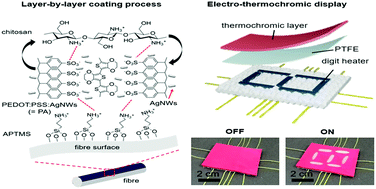Double-sided printed circuit textiles based on stencil-type layer-by-layer coating with PEDOT:PSS:Ag nanowires and chitosan for electrothermochromic displays†
Abstract
Electronic textiles (e-textiles) provide more comfort and an aesthetic value than film-based portable devices that can be developed with the conventional silicon technology. To enhance the feasibility at the industry level, it is highly desirable to develop reliable printed circuit textiles (PCTs) as a platform for commercially available circuit modules. This study demonstrates a means of fabricating PCTs with a high freedom of circuit design, a controllable pattern resolution and mechanical robustness under various hash environmental conditions. The process uses surface treatment of (3-aminopropyl)trimethoxysilane (APMTS) on a cotton textile, a layer-by-layer (LBL) coating process with a conductive dye (PEDOT:PSS:Ag nanowires) and chitosan through conformal stencil layers, and an additional coating of a polytetrafluoroethylene (PTFE) protective layer. Under optimized conditions, the PCTs show a patterning ability on both sides of the textile with a low electrical resistance of 46 Ω, a lateral dimension of 1.16 mm × 1.0 cm and reliable robustness under bending, stretching and 8585 tests. To demonstrate the feasibility of PCTs, a Joule heater and electrothermochromic display were successfully developed for e-textile applications.



 Please wait while we load your content...
Please wait while we load your content...